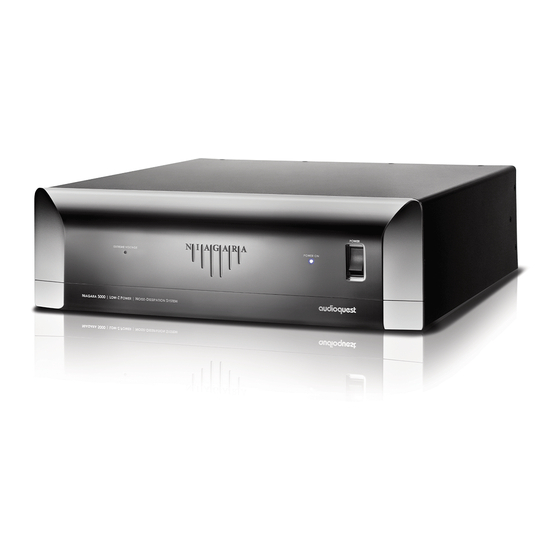AudioQuest NIAGARA 5000UK Manual del usuario - Página 7
Navegue en línea o descargue pdf Manual del usuario para Distribución de corriente alterna AudioQuest NIAGARA 5000UK. AudioQuest NIAGARA 5000UK 17 páginas. Noise-dissipation system
También para AudioQuest NIAGARA 5000UK: Manual de inicio rápido (2 páginas)

Regardless of class of operation or circuit topology (valve, solid-state, digital, or otherwise), the Transient Power
Correction Circuit will not compress the current of any power amplifier. Quite to the contrary, it will improve the
amplifier's performance by supplying the low-impedance current source that the amplifier's power supply so
desperately needs.
However, the other eight AC outlets (Level-X Ultra-Linear Noise-Dissipation System), are not appropriate for power
amplifiers. They have been optimized for line-level audio preamplifiers, DACs, universal players, turntables, and
video products that utilize constant current voltage amplifier circuits. These circuits never suffer from current
compression, but their lower input level and higher gain require a more robust means of noise dissipation. This
is key to the Niagara 5000UK's discrete AC power banks, in that not every circuit is treated the same, but rather
isolated bank by bank and optimized for best performance.
Level-X Ultra-Linear Noise-Dissipation System Power Outlets
There are four banks that utilize this technology within the Niagara 5000UK. Both of these are in turn isolated
from the High-Current/Low-Z bank (outlets 1 through 3). This offers a great advantage in controlling the complex
interactions of RF (radio frequency) and other induced noises present in the AC power supplied from your utility,
the noise that will be present on and in every AC cord, and the noise that is produced within your system's
components and that "backwashes" into the Niagara 5000UK's output circuits.
Though it would be simple to recommend putting the digital or video components into bank 2, and the line-
level audio components and turntables into banks 3, the quest for optimal performance is more complex. This
scenario will work, and likely work well, but a certain amount of experimentation is best given the fact that no
filter can eliminate 100% of all noise. The size of many of these RF-induced waveforms possess sinewaves as
small as the edge of a piece of paper, and the interactions are complex. So long as the power amplifiers are in
their appropriate banks (Outlets 1-3), and the other components are in the remaining four outlet banks (Outlets
4-5, 6-7, 8-9, 10-11), you should experience exemplary performance. Still, for the audiophile with patience, the
reward will be system performance with the highest possible resolution and lowest possible noise.
Again, because each bank is isolated from the next, placing a DAC and/or universal player in one isolated group,
and a preamplifier and turntable in another, would be an excellent way to start. For systems that are much larger
and require more outlets, try starting with the most basic setup, then adding one component at a time. The
combination that sounds best (yielding the greatest resolution) is the best one for your system!
7
